Project Categories: Small Boring Unit
Kota City Water Supply Project
Project Overview
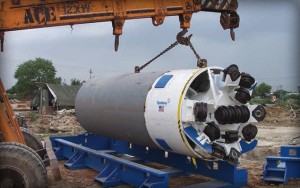 After many failed attempts, spanning the course of eight years, just three hard rock crossings remained on a vital water supply line in Kota City, Rajasthan, India. Previous contractors had attempted to excavate the crossings in hard quartzite using hand mining and HDD, which were later abandoned due to low production rates. Simply hand mining the 11 m (36 ft) long by 4.5 m (15 ft) wide launch pit took four months, at rates of 200 to 300 mm (8 to 12 in) per day. In 2008, Contractor Vichitra Constructions Pvt. Ltd. was contracted to complete the difficult 50 m (164 ft) long crossings.
After many failed attempts, spanning the course of eight years, just three hard rock crossings remained on a vital water supply line in Kota City, Rajasthan, India. Previous contractors had attempted to excavate the crossings in hard quartzite using hand mining and HDD, which were later abandoned due to low production rates. Simply hand mining the 11 m (36 ft) long by 4.5 m (15 ft) wide launch pit took four months, at rates of 200 to 300 mm (8 to 12 in) per day. In 2008, Contractor Vichitra Constructions Pvt. Ltd. was contracted to complete the difficult 50 m (164 ft) long crossings.
The 13 km (8 mi) pipeline, part of the government’s Rajasthan Urban Infrastructure Development Plan (RUIDP), was used to increase water supply and fight water contamination problems in the city. The finished system provides 24 million liters (6.3 million gallons) of water per day to about 70,000 people.
After researching various technologies, Vichitra purchased a 1.5 m diameter Robbins Small Boring Unit (SBU-A) with 11.5 inch disc cutters and a Robbins 60-1270 Auger Boring Machine (ABM). The technology was supplied by Robbins Tunneling and Trenchless Technology (India) Pvt Ltd, a local subsidiary based in New Delhi who also provided the contractor with technical support, crew members, and cutter rebuild services.
Geology
Much of the crossings consisted of quartzite rock (200-250 MPa / 29,000-36,000 psi), with some tracts of soil and mud. The excavation was remarkable considering the machine bored rock strengths outside the normal range generally excavated by SBU-As.
SBU-A
Small Boring Units, available in diameters from 24 to 72 inches, are typically used on crossings up to 500 ft in length utilizing a standard Auger Boring Machine (ABM) and steel casing. During excavation, the SBU-A is welded to the lead casing while the ABM provides both torque and forward thrust to the cutting head. The circular cutterhead is fitted with single disc cutters to excavate hard rock, or a combination of single disc cutters, two-row tungsten carbide insert cutters, and carbide bits in mixed ground. Disc cutters penetrate the rock face, creating a “crush zone” through which fractures propagate. Material between adjacent crush zones then falls from the face. Muck scrapers scoop the muck into openings on the cutterhead. Muck is then transferred through a full-face auger for removal.
Crossing Excavation
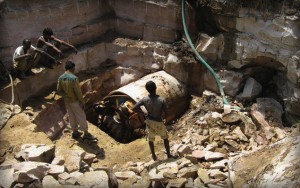 Three rail bores were completed by autumn 2008 in abrasive, hard rock. The crossings below a railroad were excavated in two 50-m (164-ft) long passes from either side of the tracks. The first pass, with advance rates of 1.5-m (5-ft) per hour, broke through into a center pit located between the two sets of tracks. A third 14-m (46-ft) long bore was added underneath a roadway after difficulties with open-cut operations in hard rock.
Three rail bores were completed by autumn 2008 in abrasive, hard rock. The crossings below a railroad were excavated in two 50-m (164-ft) long passes from either side of the tracks. The first pass, with advance rates of 1.5-m (5-ft) per hour, broke through into a center pit located between the two sets of tracks. A third 14-m (46-ft) long bore was added underneath a roadway after difficulties with open-cut operations in hard rock.
Milford Haven Gas Connection Project
Motorized SBUs Power through Rock on U.K. Pipeline
Project Overview
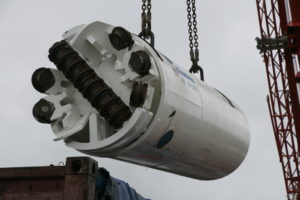 In one of the U.K.’s most extensive infrastructure developments, the Milford Haven Gas Connection Project extends over 300 km (190 mi) across South Wales. The pipeline was created to deliver liquefied natural gas (LNG) from a port at Milford Haven, providing up to 20% of the U.K.’s natural gas for owner National Grid.
In one of the U.K.’s most extensive infrastructure developments, the Milford Haven Gas Connection Project extends over 300 km (190 mi) across South Wales. The pipeline was created to deliver liquefied natural gas (LNG) from a port at Milford Haven, providing up to 20% of the U.K.’s natural gas for owner National Grid.
Constructed in two phases, work began on the pipeline in early 2006. Both phases were finished in November 2007. Phase I involved a 120 km (75 mi) long stretch from the towns of Milford Haven to Aberdulais. Phase II of the project extended the pipeline another 185 km (115 mi) from Felindre to Tirley in Gloucestershire.
General Contractor NACAP/Land & Marine constructed many of the crossings for both Phases I and II, subcontracting some hard rock crossings to local contractor B&W Tunnelling Ltd. B&W utilized three 1.2 m (48 inch) Robbins SBU-As and two 1.2 m (48 inch) Robbins SBU-Ms to excavate 62 crossings ranging from 20 to 80 m (65 to 260 ft) in length.
Geology
The majority of crossings were located in siltstone and mudstone rock (70 to 200 MPa/ 10,000 to 29,000 psi UCS), with some interbedded clay and gravel.
Motorized SBU
B&W Tunnelling opted for the Motorized SBU (SBU-M) due to the challenging contractual line and grade restrictions on their four longest bores. The 50 mm (2 in) tolerance meant they needed a machine with increased accuracy and continuous monitoring.
The Motorized SBU is a manned-entry, hard rock boring machine used for longer bores (over 150 m/ 500 ft in length) and for line- and grade-critical crossings. The machine is used in conjunction with a standard Auger Boring Machine (ABM) or pipe jacking unit and is welded to the lead casing in the same fashion as SBU-As. The machine is continuously steered from an operator’s console inside the rear shield, and uses a laser targeting system to monitor the machine’s heading.
B&W utilized two Motorized SBUs, one for hard rock and one for mixed ground. The mixed ground cutterhead featured 9.5″ diameter single disc cutters and larger muck openings to tackle the sections of rock interbedded with clay and gravels.
Tunnel Excavation
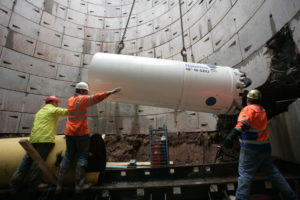 All crossings were excavated successfully, typically averaging from 1.5 to 2.0 m (5.0 to 6.5 ft) per hour. Each of the SBU-A crossings utilized a 1.2 m (48 inch) ABM and required shallow launch pits measuring 24 m (80 ft) long x 3 m (10 ft) wide. Incredibly, the three SBU-A machines completed 53 crossings of 30 m (100 ft) in length (a total of approximately 1,600 m/ 5,300 ft bored) with only a single cutter change.
All crossings were excavated successfully, typically averaging from 1.5 to 2.0 m (5.0 to 6.5 ft) per hour. Each of the SBU-A crossings utilized a 1.2 m (48 inch) ABM and required shallow launch pits measuring 24 m (80 ft) long x 3 m (10 ft) wide. Incredibly, the three SBU-A machines completed 53 crossings of 30 m (100 ft) in length (a total of approximately 1,600 m/ 5,300 ft bored) with only a single cutter change.
Each of the Motorized SBU crossings required the use of 10 to 30 m (33 to 100 ft) deep launch and recovery shafts. The 10.5 m (35 ft) diameter shafts were lined with concrete-bolted segmental rings and were used to install the pipeline after the crossing had been excavated. Sacrificial casing (steel, 1.2 m/ 48 in O.D.) was used to provide the necessary forward thrust to the cutting face from the ABM. The pipe was later removed and a semi-automatic welding bug was used to install the final pipeline.
Chester Boulevard Interceptor Sewer
Rockhead Makes Short Work of Indiana Crossings
Project Overview
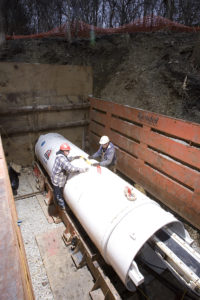 The city of Richmond, Indiana is a growing community of 50,000 people. To meet future projections, the city created a plan to double the current capacity of its sewer system via a 6.4 km (4 mi) long extension. The new gravity sewer would also eliminate the need for costly pump stations.
The city of Richmond, Indiana is a growing community of 50,000 people. To meet future projections, the city created a plan to double the current capacity of its sewer system via a 6.4 km (4 mi) long extension. The new gravity sewer would also eliminate the need for costly pump stations.
In December 2006, the Richmond Sanitary District awarded a USD $4.7 million contract to general contractor Brackney, Inc for construction of the Chester Boulevard Interceptor Sewer—a 3.2 km (2 mi) stretch of the new pipeline to provide service to a commercial district and nearby hospital. Subsequently, Midwest Mole, Inc. was subcontracted by Brackney to excavate four hard rock crossings underneath a river and historic walking trails. Midwest Mole opted to use a 1.2 m (48 inch) diameter SBU-A for the two shortest bores (55m / 180 ft in length), and a 1.4 m (54 inch) Single Shield Rockhead for the two longest bores of 120 m (400 ft) each.
Geology
The crossings were located in shale and limestone rock up to 70 MPa (10,200 psi) UCS. All of the crossings were in competent ground with little to no water inflows.
Rockhead
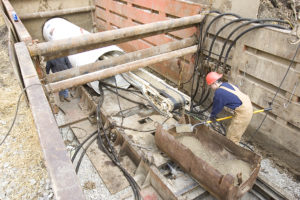 Rockheads are the most efficient technology for hard rock or mixed ground conditions from 25 to over 175 MPa (4,000 to over 25,000 psi) UCS that are above the water table. Midwest Mole decided on a Robbins Rockhead for the longest bores due to the length of the crossings and the strict line and grade requirements. Both crossings required accurate excavation at a grade of 0.25%–an easy feat for the Rockhead, which is continuously steered via an operator’s console inside the machine’s rear shield.
Rockheads are the most efficient technology for hard rock or mixed ground conditions from 25 to over 175 MPa (4,000 to over 25,000 psi) UCS that are above the water table. Midwest Mole decided on a Robbins Rockhead for the longest bores due to the length of the crossings and the strict line and grade requirements. Both crossings required accurate excavation at a grade of 0.25%–an easy feat for the Rockhead, which is continuously steered via an operator’s console inside the machine’s rear shield.
The cutterhead on the 1.4 m (54 inch) machine was fitted with 6.5″ diameter patented Single Disc Cutters for optimal boring in solid rock. The machine is owned by Midwest Mole and had been used on six previous projects since 2005. After boring over 1,200 m (3,900 ft), the machine was sent in to the Robbins shop for its first refurbishment and change of cutters prior to the set of gravity sewer crossings.
Tunnel Excavation
Midwest Mole excavated the first 120 m (400 ft) long crossing in March 2007. The Rockhead was welded to the lead 1.4 m (54 in) diameter steel casing and launched from the bore pit using a pipe jacking system. The machine averaged 6 to 8 m (20 to 26 ft) per 10-hour shift, finishing both on time and within grade requirements.The second crossing excavation began in May 2007, with the machine accomplishing even better excavation rates of up to 9 m (30 ft) per shift.
Both SBU-A crossings were finished with similar results. Each of the 55 m (180 ft) crossings, on a 0.42% grade, required continuous monitoring of the machine’s heading. Stabilizer pads, located in each quadrant of the machine, were used to stabilize the machine and allow for steering during the first 6 to 8 m (20 to 26 ft) of the bore. Crews adjusted the machine’s heading by changing the height of the stabilizer pads using a hydraulic cylinder. After the first 6 to 8 m (20 to 26 ft), monitoring alignment required the use of a dutch level. If the alignment had drifted the auger was then pulled and reset on the correct heading. The machine averaged up to 6 m (20 ft) per 10-hour shift on both crossings.
Glenwood Cable Tunnel
Project Overview
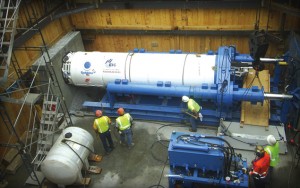 EIC Associates were contracted in 2006 to construct over 13 km (8 mi) of a 115 kV power transmission line through Stamford, Darien, and Norwalk in Connecticut, USA. The final system includes three circuits consisting of 92 vaults and 62 handholds. EIC used a Robbins 1.5 m (60 in) Double Shield Rockhead (SBU-RHDS) to excavate two crossings under the Metro North Railroad in Darien, which turned out to be particularly difficult rock.
EIC Associates were contracted in 2006 to construct over 13 km (8 mi) of a 115 kV power transmission line through Stamford, Darien, and Norwalk in Connecticut, USA. The final system includes three circuits consisting of 92 vaults and 62 handholds. EIC used a Robbins 1.5 m (60 in) Double Shield Rockhead (SBU-RHDS) to excavate two crossings under the Metro North Railroad in Darien, which turned out to be particularly difficult rock.
Due to the very poor ground conditions, G. Donaldson, a division of Hayward-Baker, Inc., was contracted to pre-grout utilizing two types of pre-grouting. The two types of grouting used were: horizontal grouting to stabilize the tunnel alignment, and vertical grouting around the road and rail structures to help reduce the risk of surface settlement.
Geology
Exploratory testing of the bore area found highly fractured meta-quartz monzonite ranging from 5,000 to 20,000 psi (35 to 140 MPa) UCS with Rock Quality Designations averaging 45%. Due to the unstable ground conditions, the location of the tunnel was lowered an additional 3 m (9 ft). However, further testing found extensive fractures here as well.
Rockhead
Rockheads are best suited for longer tunnels, where line-and-grade are critical such as in gravity sewers. EIC chose to use the best available option, the Robbins Double Shield Rockhead, due to the instability of the rock as well as the length of the bore.
The 1.5 m (60 in) diameter Double Shield machine, designed specifically for the highly fractured rock, featured a breasted plate cutterhead, which consisted of a steel plate in front of the standard cutterhead with slots for the single disc cutters. Grill bars were also added across the muck chutes to limit the size of rock allowed onto the conveyor.
Tunnel Excavation
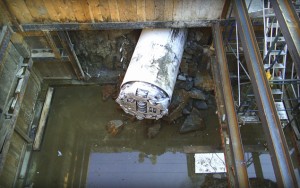 Excavation started in the spring of 2008, operating six days a week in two ten-hour shifts. The machine bored the two crossings averaging 254 to 635 mm (10 to 25 in) per hour, due to rock hardness. Using articulation cylinders and stabilizer pads, the machine was able to maintain line and grade throughout the bore. EIC elected to use reinforced concrete pipe for the lining, which was laid behind the machine using a pipe jacking system.
Excavation started in the spring of 2008, operating six days a week in two ten-hour shifts. The machine bored the two crossings averaging 254 to 635 mm (10 to 25 in) per hour, due to rock hardness. Using articulation cylinders and stabilizer pads, the machine was able to maintain line and grade throughout the bore. EIC elected to use reinforced concrete pipe for the lining, which was laid behind the machine using a pipe jacking system.
Throughout the bore, field service technicians adjusted the penetration rate of the machine, as pre-grouted sections made the rock face softer and easier to excavate. This adjustment required either a decrease in thrust cylinder pressure or cutterhead speed to avoid plugging the muck removal system with too much debris. The machine’s variable speed electric drive allowed for fine tuning throughout the drive.
Locust Street Sanitary Improvements Project No. 6335
Project Overview
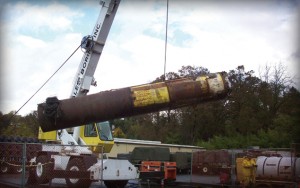 In Tigard, Oregon, upwards of 1.8 km (1.1 mi) of gravity sewer were installed by general contractor Northwest Earthmovers Inc. for project owner Clean Water Services. Gonzales Boring & Tunneling was subcontracted to complete three crossings, which formed part of the Locust Street Sanitary Improvements Project No. 6335. The three crossings measured 70 m (230 ft), 183 m (600 ft), and 98 m (320 ft) in length. The 450 mm (18 in) diameter PVC carrier pipe was laid to increase wastewater capacity in the area and stop overflows currently plaguing the system.
In Tigard, Oregon, upwards of 1.8 km (1.1 mi) of gravity sewer were installed by general contractor Northwest Earthmovers Inc. for project owner Clean Water Services. Gonzales Boring & Tunneling was subcontracted to complete three crossings, which formed part of the Locust Street Sanitary Improvements Project No. 6335. The three crossings measured 70 m (230 ft), 183 m (600 ft), and 98 m (320 ft) in length. The 450 mm (18 in) diameter PVC carrier pipe was laid to increase wastewater capacity in the area and stop overflows currently plaguing the system.
Gonzales Boring & Tunneling purchased a Robbins 1.0 m (42 in) SBU-A to complete the three crossings located below houses, neighborhood streets, a small creek, and a service facility.
Geology
Rock conditions on the first crossing consisted of clay and basalt, while the second crossing was composed of basalt at various rock strengths ranging from 48 to 82 MPa (7,000 to 12,000 psi). Sections of the crossings were also interspersed with dirt containing small boulders.
SBU-A Features
Robbins SBU cutterheads can be equipped with a variety of tungsten carbide bits and single or multi-row disc cutters depending on the ground conditions. The SBU cutterhead for the Gonzales Boring crossings was fitted with 165 mm (6.5 in) single disc cutters and larger muck bucket openings to handle the mixed ground conditions.
During the launch of the machine, the SBU-A was welded to the lead steel casing. The cutterhead was propelled forward via torque and thrust from the Auger Boring Machine (ABM). Spoil was removed through openings in the cutterhead called muck buckets and discharged using a full-face auger.
Tunnel Excavation
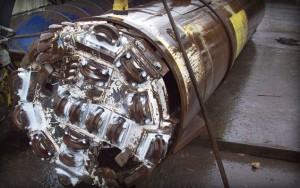 Workers monitored line and grade, and were able to maintain advance rates of 12 m (40 ft) per 10-hour shift. Using a contractor-designed steering system, the SBU-A holed through within one hundredth of an inch design grade after 183 m (600 ft) of excavation. In addition to having the record for the longest single crossing length, 183 m (600 ft), the machine required no cutter changes after 250 m (830 ft) of boring. A third crossing of 98 m (320 ft) was also excavated in early 2010.
Workers monitored line and grade, and were able to maintain advance rates of 12 m (40 ft) per 10-hour shift. Using a contractor-designed steering system, the SBU-A holed through within one hundredth of an inch design grade after 183 m (600 ft) of excavation. In addition to having the record for the longest single crossing length, 183 m (600 ft), the machine required no cutter changes after 250 m (830 ft) of boring. A third crossing of 98 m (320 ft) was also excavated in early 2010.
Big Sky
Project Overview
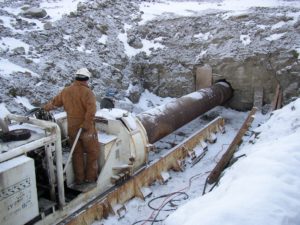 The Yellowstone Club, a private resort in Big Sky Montana, includes an 18-hole championship mountain golf course in addition to miles of ski trails. This golf course is irrigated by 318 ft (96.9 m) of pipeline from a nearby 79 million gallon reservoir.
The Yellowstone Club, a private resort in Big Sky Montana, includes an 18-hole championship mountain golf course in addition to miles of ski trails. This golf course is irrigated by 318 ft (96.9 m) of pipeline from a nearby 79 million gallon reservoir.
In 2005, the project owner contracted Tunnel Systems Inc. to bore the pipeline. The contractor started out with an Auger Boring Machine with a Christmas tree’ head attachment. However, they ran into problems 59 feet (18 m) into the dig when they began boring through hard rock. The next two days of the bore cleared only 16 feet (4.9 m). For the rest of the dig, Tunnel Systems Inc. leased a Robbins 30 in (762 mm) diameter Small Boring Unit (SBU).
Geology
The section of pipeline through hard rock contained mixed ground conditions including sections of solid rock and mixed rock with soil.
SBU
Tunnel Systems elected to utilize a Robbins SBU because they are designed for bores just like this project — in rock with an Unconfined Compressive Strength (UCS) greater than 24,000 kPa (3.5 ksi). They utilized an SBU without stabilizer feet, available on 30 in (762 mm) and 24 in (609 mm) models. Stabilizer feet are standard on all SBU models 36 in (914 mm) in diameter and above, as well as available on some 30 in (762 mm) models. The SBU featured Robbins’ patented disc cutters to obtain the highest advance rates in hard rock. The SBU’s design is based on the same technology as the large-diameter tunnel boring machines.
Tunnel Excavation
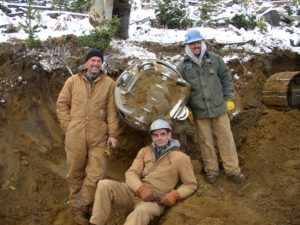 At the jobsite, the SBU was welded to the lead pipe casing. In order for the boring to begin, the SBU received thrust from the pipe casing and torque from the Auger Boring Machine (ABM). Muck was then removed through the auger.
At the jobsite, the SBU was welded to the lead pipe casing. In order for the boring to begin, the SBU received thrust from the pipe casing and torque from the Auger Boring Machine (ABM). Muck was then removed through the auger.
Upon restarting the dig, the SBU achieved impressive advance rates of 43-49 ft (13.1-14.9 m) per day. The ABM and SBU bored through solid rock for approximately 197 ft (60 m) and bored through mixed rock and soil for the final 20 ft (6 m).
The SBU finished the project on time despite some setbacks. Harsh weather conditions on the job site of 19 degrees Fahrenheit (-7 degrees Celsius) and 40 mph (65 km/h) winds made it too difficult to work and the bore was forced to halt until the snowstorm passed. The crew completed the project in just a few hours on the following day.
Tahoe Forest Hospital District Central Energy Plant Prep Project
Project Overview
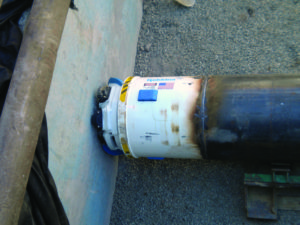 The Tahoe Forest Hospital is an expanding healthcare center located in Truckee, California. In autumn 2010, they were in the process of designing a new cancer wing when it was determined that additional utility and mechanical lines were required before the new building could be built. To house the bundled utilities, three crossings needed to be bored directly below the active main hospital.
The Tahoe Forest Hospital is an expanding healthcare center located in Truckee, California. In autumn 2010, they were in the process of designing a new cancer wing when it was determined that additional utility and mechanical lines were required before the new building could be built. To house the bundled utilities, three crossings needed to be bored directly below the active main hospital.
General contractor AM-X Construction & Excavation, Inc. subcontracted the three parallel 21 m (70 ft) sections to Silver State Boring Inc. Due to variable ground conditions and hospital noise constraints, the contractor opted for a Robbins SBU-A with a mixed ground head. This was the first time Silver State had used this type of cutterhead, but they were confident that it was the right machine for the job.
Geology
The hospital is set on ground containing large granite boulders, and Silver State was worried that one of these rocks would be hit during boring. This concern was actualized 7.6 m (25 ft) into the first bore when the SBU-A caught the edge of a boulder about 3.7 m (12 ft) in diameter. During the second bore, the machine drilled straight through the same boulder. Additional boulders of 175 MPa (25,000 psi) UCS were encountered during the third bore, and the SBU-A successfully powered through them as well.
What is a Mixed Ground SBU-A?
The Robbins SBU-A is a circular cutting head mounted with a combination of tungsten carbide bits, single disc cutters, and multi-row disc cutters. The SBU-A is available in diameters from 600 mm to 1.8 m (24 to 72 in), and can excavate a wide variety of hard rock and mixed ground conditions including dry soils, clay, cobbles and boulders from 25 to 175 MPa (4,000 to 25,000 psi) UCS.
During boring, the SBU-A is welded to an Auger Boring Machine (ABM), which provides both torque and thrust to the cutting head. Drag bits scrape soil from the machine face, while disc cutters excavate sections of rock. Muck scrapers scoop the excavated rock into large openings in the cutterhead, allowing for a smooth flow of muck from the face to the auger string.
Excavation
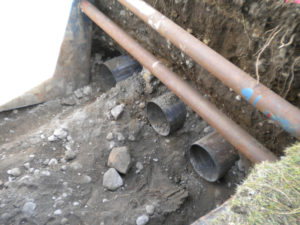 The SBU-A bored 2 m (8 ft) below the hospital’s foundation for the three jack-and-bore crossings. Straight bores were needed due to tight exit space, and each one began with a 609 mm (24 in) thick concrete starting block to keep the machine properly aligned. In addition, the older hospital has many buried utilities that needed to be cut and bypassed during site excavation. To make sure that everything would run smoothly, Robbins field service technicians visited the site prior to launch to assist with setup and crew training.
The SBU-A bored 2 m (8 ft) below the hospital’s foundation for the three jack-and-bore crossings. Straight bores were needed due to tight exit space, and each one began with a 609 mm (24 in) thick concrete starting block to keep the machine properly aligned. In addition, the older hospital has many buried utilities that needed to be cut and bypassed during site excavation. To make sure that everything would run smoothly, Robbins field service technicians visited the site prior to launch to assist with setup and crew training.
The first of the three bores began in October 2010, and by November 2010 all three bores were successfully completed. Advance rates for the duration of the project were approximately 3 m (10 ft) per day.
Due to the low torque and impact of the SBU-A, little stress was put on the ABM, no cutter changes were needed between bores, and the hospital was unaffected by noise or vibration during boring. Silver State was very pleased with the results, and used the technology again in 2011 for 609 mm (24 in) diameter bore in South Lake Tahoe, Nevada.
City of Clinton Contract B Force Main Project
Project Overview
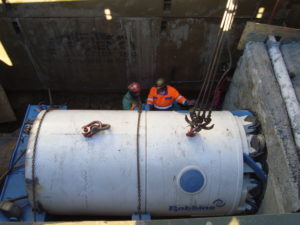 The Iowan towns of Clinton, Camanche and Low Moor have been identified as communities in desperate need of updated wastewater treatment systems. The towns all have over 10,000 residents, but their water and sewer treatment plants are inadequate and often over capacity. In 2009, a statewide recovery program called I-JOBS was created in Iowa, and USD $20 million in project funding was allocated to improving water quality. These funds were set aside for water treatment projects in the three towns.
The Iowan towns of Clinton, Camanche and Low Moor have been identified as communities in desperate need of updated wastewater treatment systems. The towns all have over 10,000 residents, but their water and sewer treatment plants are inadequate and often over capacity. In 2009, a statewide recovery program called I-JOBS was created in Iowa, and USD $20 million in project funding was allocated to improving water quality. These funds were set aside for water treatment projects in the three towns.
The City of Clinton awarded their portion of the funding, USD $9.5 million, to general contractor Merryman Excavation. Illinois-based L.J. Keefe Co. was chosen as the sub-contractor for the project. The contract, known as City of Clinton Contract B Force Main, called for six crossings below roadways and rivers, three of which required TBM tunneling. The remaining three crossings required SBUs. Two Robbins SBU-As were chosen for the 26.2 m (250 ft) and 82.3 m (270 ft) runs, and a third Robbins motorized SBU (SBU-M) was selected for the 120.4 m (395 ft) crossing.
Geology
The 26.2 m (250 ft) and 82.3 m (270 ft) crossings undercut the Mississippi river, and were identified as hard rock bores of over 70 MPa (10,000 psi) UCS in which SBU-As would be the best choice. The longest crossing was below traffic-heavy Highway 67, and testing of the area revealed a mixed face of sand, clay and 70 MPa (10,000 psi) UCS hard rock. Due to the variable ground conditions, the contractor opted for a 1.8 m (72 in) SBU-M, the largest of its kind yet built.
About the SBU-A
The Small Boring Unit (SBU-A) is a hard rock and mixed ground circular cutterhead which utilizes an Auger Boring Machine (ABM) and steel casing. During excavation, the SBU-A is welded to the lead casing while the ABM provides torque and forward thrust to the cutterhead.
The SBU-A is available in diameters ranging from 600 mm to 1.8 m (24 to 72 in), and its single disc cutters are capable of excavating rock from 25 to over 175 MPa (4,000 to over 25,000 psi) UCS. The cutters penetrate the rock face, creating a “crush zone” through which fractures occur. Material between adjacent crush zones falls from the face into muck buckets in the cutterhead. A full face auger is used to transfer the muck for removal.
About the SBU-M
The SBU-A’s cousin, the SBU-M, is a motorized SBU used for longer bores and line-and-grade critical crossings. In similar fashion to the SBU-A, the SBU-M is welded or bolted to the lead casing of an ABM. The machine is continuously steered by way of an operator’s console in the rear shield. A laser targeting system is used to monitor the machine’s heading. These features allow for increased accuracy and continuous monitoring, which was needed on the 120.4 m (395 ft) bore due to the mixed ground geology, strict line-and-grade requirements, and crossing length.
Excavation
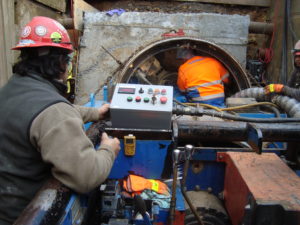 In November and December 2011, the 1.5 m (60 in) and 1.06 m (42 in) SBU-As, respectively, were launched 9.1 m to 10.6 m (30 to 35 ft) beneath a tributary of the Mississippi River. Each utilized an 18.3 m (60 in) ABM to excavate in the hard rock conditions. Both SBU-As broke through on time and within line-and-grade specifications. The first SBU reached completion on December 20, 2011, and its counterpart did the same on February 10, 2012. Each averaged advance rates of 6.1 m (20 ft) per day.
In November and December 2011, the 1.5 m (60 in) and 1.06 m (42 in) SBU-As, respectively, were launched 9.1 m to 10.6 m (30 to 35 ft) beneath a tributary of the Mississippi River. Each utilized an 18.3 m (60 in) ABM to excavate in the hard rock conditions. Both SBU-As broke through on time and within line-and-grade specifications. The first SBU reached completion on December 20, 2011, and its counterpart did the same on February 10, 2012. Each averaged advance rates of 6.1 m (20 ft) per day.
The 1.8 m (72 in) SBU-M was launched in January 2012 from a 7.6 m (25 ft) launch pit. Although the machine encountered an unexpectedly long drive of hard clay just 4.6 m (15 ft) into its bore, crews were able to keep moving by adding water through the cutterhead and the casing. This kept the muck coming through without contaminating the disc cutters.
Although challenging, advance rates of 6.2 m (20 ft) per day were maintained in the softer ground conditions. After about 70.1 m (230 ft) worth of clay, the machine hit solid rock for the remainder of the run. While in hard rock, rates increased to about 90.1 m (30 ft) per day.
On February 14, 2012, the SBU-M broke through into a receiving pit. It finished within line-and-grade requirements with very little deviation, even in the mixed face ground conditions during initial boring.
Shayler Run Segment C Sewer Replacement Project
Project Overview
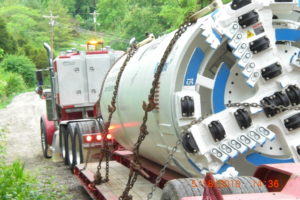 Seven new sewer tunnels were recently completed in Ohio’s Clermont County, replacing an outdated and exposed system that was dumping raw sewage into local Shayler Creek. Since 1978, when the previous pipeline was installed, the creek had eroded, exposing the pipe and putting certain sections of the line at high risk of failure. For all of these reasons, a new pipeline needed to be installed far below the environmentally-sensitive waterway.
Seven new sewer tunnels were recently completed in Ohio’s Clermont County, replacing an outdated and exposed system that was dumping raw sewage into local Shayler Creek. Since 1978, when the previous pipeline was installed, the creek had eroded, exposing the pipe and putting certain sections of the line at high risk of failure. For all of these reasons, a new pipeline needed to be installed far below the environmentally-sensitive waterway.
The Clermont County Water Resources Department hired Indianapolis contractor Midwest Mole for the $15M USD project, and chose to use only one machine for the seven tunnels. A 1.8 m (72 in) diameter Robbins Double Shield Rockhead was used to excavate all of the tunnels, totaling 2,900 m (9,513 ft). The contractor’s unique approach also included eliminating three shafts from the original bid, which shortened the project schedule and significantly lowered costs.
Ground Conditions
Because of the project location below the creek bed, ground conditions were highly varied, consisting of interbedded layers of limestone and shale that ranged from dry to sticky and wet. To accommodate the mixed ground, the machine was outfitted with a mixed ground cutterhead that could be swapped out for a hard rock cutterhead based on the ground conditions at each crossing.
The mixed ground cutterhead featured 6.5 in single disc cutters and carbide bits, while the hard rock cutterhead contained 11.5 in single cutters and abrasion-resistant muck scrapers. Both cutterheads had large openings which allowed for efficient cutter changes.
About the SBU-RHDS
The Robbins Double Shield Rockhead (SBU-RHDS) is a tunneling machine typically used on utility installations of over 150 m (500 ft). Its continuous steering capabilities and laser targeting system make it the ideal solution for line-and-grade critical installations such as the Shayler Run Segment C Sewer Replacement Project.
The SBU-RHDS is available in diameters from 1.4 to 2.0 m (54 to 78 in), and consists of a cutterhead optimized for mixed and hard rock ground conditions. The machine’s circular cutterhead contains disc cutters capable of excavating ground ranging from 25 to 175 MPa (4,000 to over 25,000 psi) UCS.
As the cutterhead rotates, the cutters penetrate the rock face creating “crush zones” through which fractures propagate. Material between adjacent crush zones is then chipped from the face. Muck scrapers scoop the muck into muck buckets, which transfer the muck onto a machine belt conveyor. Muck is transported offsite via conveyor belt or muck cars.
Excavation
 A total of seven tunnel crossings connected by eight shafts were constructed by Midwest Mole. The tunnels utilized the Rockhead, while the shafts were constructed using a combination of drill and blast techniques and manual excavation. A primary liner of ring beams and lagging was installed every 1.5 m (5 ft) at each crossing. Even with liner installation, high production rates of 12 to 18 m (40 to 60 ft) per 12-hour shift were maintained for the project duration.
A total of seven tunnel crossings connected by eight shafts were constructed by Midwest Mole. The tunnels utilized the Rockhead, while the shafts were constructed using a combination of drill and blast techniques and manual excavation. A primary liner of ring beams and lagging was installed every 1.5 m (5 ft) at each crossing. Even with liner installation, high production rates of 12 to 18 m (40 to 60 ft) per 12-hour shift were maintained for the project duration.
Due to the gravity sewer construction, each tunnel had strict line-and-grade requirements of within 300mm (1 ft) of line at 1 to 2% grade, which was continuously monitored from an in-shield operator’s console. Over the course of the project, the variance resulted in a vertical change of 53.9 m (177 ft) causing the machine to bore through a wide range of ground conditions.
Excavation of the initial 484.3 m (1,589 ft) crossing began in May 2010 in mixed ground, and the Rockhead broke through to its first shaft site that August. After a few minor modifications to the hydraulic and muck haulage systems, the machine began boring the second 575.4 m (1,888 ft) crossing.
Crossings 3 and 4, 321.9 m (1,056 ft) and 304.8 m (1,000 ft), respectively, were excavated in December 2010 and January 2011 in adverse winter weather conditions. In order to keep tunneling during freezing temperatures, the contractor heated the machine’s cooling water overnight. Cooling water was recycled and filtered, then stored in 7, 500 l (2,000 gal) tanks with heaters. Using this technique, production rates stayed high and both crossings were successfully excavated by January 2011.
The Rockhead began its fifth and longest crossing of 613.8 m (2,014 ft) in April 2011, and reached a world record in tunneling distance for a hard rock machine of its 1.8 m (72 in) diameter. For the last two crossings, 402.3 m (1,320 ft) and 196.9 m (646 ft), respectively, the mixed ground cutterhead was replaced with its hard rock counterpart.
Due to negotiations with local landowners and a change in shaft location, the final crossing began in January 2012. A month later, the drive was completed. In July 2012, the entire project reached completion right on schedule, with all manholes and ancillary sewers tied in and in service.
Recent Posts
- World Tunnel Congress 2024
- Use of a Tunnel Boring Machine on Nepal’s First and Second TBM-Driven Tunnels
- Robbins Double Shield Sets Record in Nepal
- Final Breakthrough at Bahçe-Nurdaği Railway
- Record-Setting Large Diameter Mixed Ground Tunneling in Turkey: The Eşme-Salihli Railway Tunnel

 Close
Close  Menu
Menu 